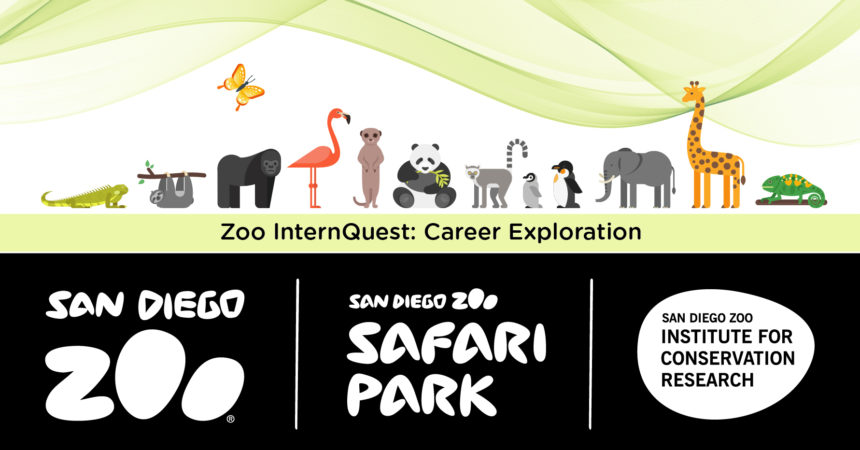Zoo InternQuest is a seven-week career exploration program for San Diego County high school juniors and seniors. Students have the unique opportunity to meet professionals working for the San Diego Zoo, Safari Park, and Institute for Conservation Research, learn about their jobs, and then blog about their experience online. Follow their adventures here on the Zoo’s website!
It is common knowledge that raising children requires a lot of work. Now imagine that you are raising six children, and all six children are around 15 feet tall. For Erica Rustich, this idea is reality. Ms. Rustich is a Senior keeper at the San Diego Zoo who primarily works with giraffes.
As one would imagine, every workday is both eventful and exciting for Ms. Rustich. She begins her days in the early hours, usually starting around 5:15 am. A typical schedule for Ms. Rustich generally consists of feeding and training the giraffes, and cleaning their enclosure. In order to provide her giraffes with the most natural experience possible, Ms. Rustich feeds her giraffes using methods which allow them to mimic their feeding behaviors in the wild. For example, rather than laying Acacia leaves around for the giraffes to snack on she places Acacia branches high up in the enclosure, thorns and all, as to mimic actual trees in the wild. This allows the giraffes to use their agile tongues and thick saliva in order to pick the leaves off of the branches, while avoiding thorns and other obstacles.
Occasionally, there are days in which events that are not so typical take place, such as the birth of a baby giraffe, also known as a calf. Before the giraffe’s birth, Ms. Rustich can usually tell if a giraffe is pregnant through significant weight changes and a swollen belly. However, the exact amount of time which a giraffe is pregnant is unpredictable, ranging from 14 all the way up to 16 months. This means that around 13 months, Ms. Rustich has to be prepared at all times for a giraffe to go into labor. Some of this preparation involves the creation of a “maternity pen”, which is a closed off area that offers a pregnant giraffe privacy and a safe place to give birth, as it prevents other giraffes from getting in her way. Ms. Rustich can only know for sure when a giraffe is about to go into a labor when she sees two hooves peeking out of their underside. This is an indication that in about two hours, a giraffe is about to give birth to a newborn calf. Once a calf is born, the privacy of the maternity pen allows for the initial bonding between mother and calf, which is critical for the mother’s future with the calf when they are introduced back into the main enclosure.
In order to better the lives of the giraffes, there are some things in their lives, such as medical check ups and procedures, which are activities that giraffes do not typically take part in in the wild. In order to make these processes as comfortable as possible for each giraffe, giraffes go through training conducted by Ms. Rustich so that they are more comfortable during these sessions. The training Ms. Rustich implements with the giraffes is trust based, and the giraffes always have the choice to not participate if they wish not to do so. One of the main things that giraffes are trained to do is enter a “chute” which is a modified cattle squeeze that allows access to the giraffe from both sides. This allows the giraffes to be safely contained without the need for sedation, which is potentially dangerous for such large animals. The chute is mainly used by veterinarians, who can use it to take radiographs, or perform other procedures such as blood tests or IV administration.
All the things mentioned above are things which Ms. Rustich does behind the scenes of what you see at the zoo. One thing you may have seen Ms. Rustich do is present a public feeding for Zoo guests. While not directly necessary for the livelihood giraffes, such events help promote research, for example giraffe tracking which aids in the conservation of giraffes and their natural habitats. These feedings can provide visitors with, as Ms. Rustich describes it, a “touch of nature” that will hopefully inspire them for the rest of their lives.
In all, Ms. Rustich really is like a mother to her giraffes, in that her care and sacrifices she makes for them is similar to that of a mother. She is there for her giraffes in their ups and downs, and knows them better than anyone. For these reasons, Ms. Rustich is able to love her job in the same way a mother loves her child.
Evelyn, Real World Team
Week Six, Winter Session 2019


